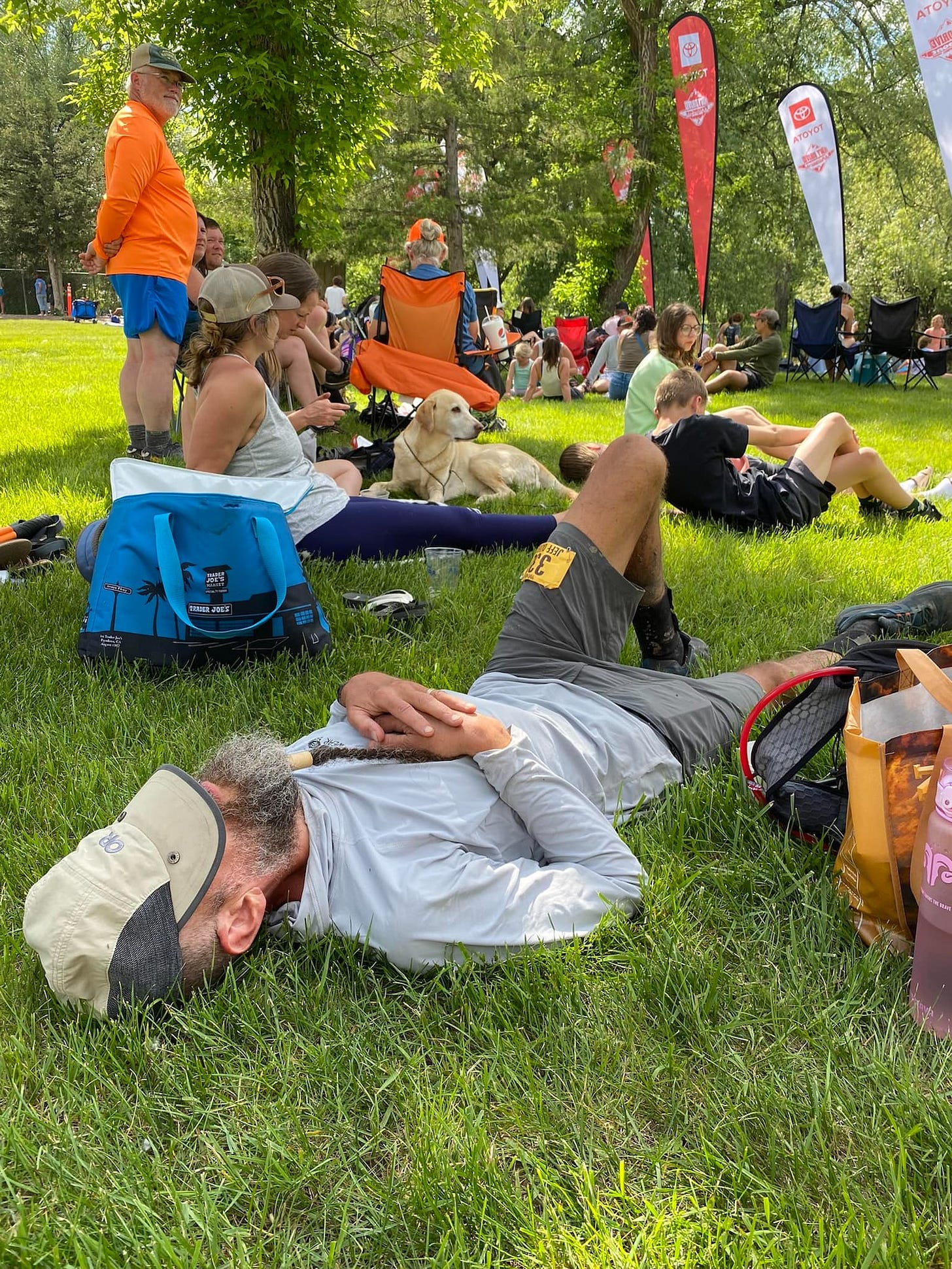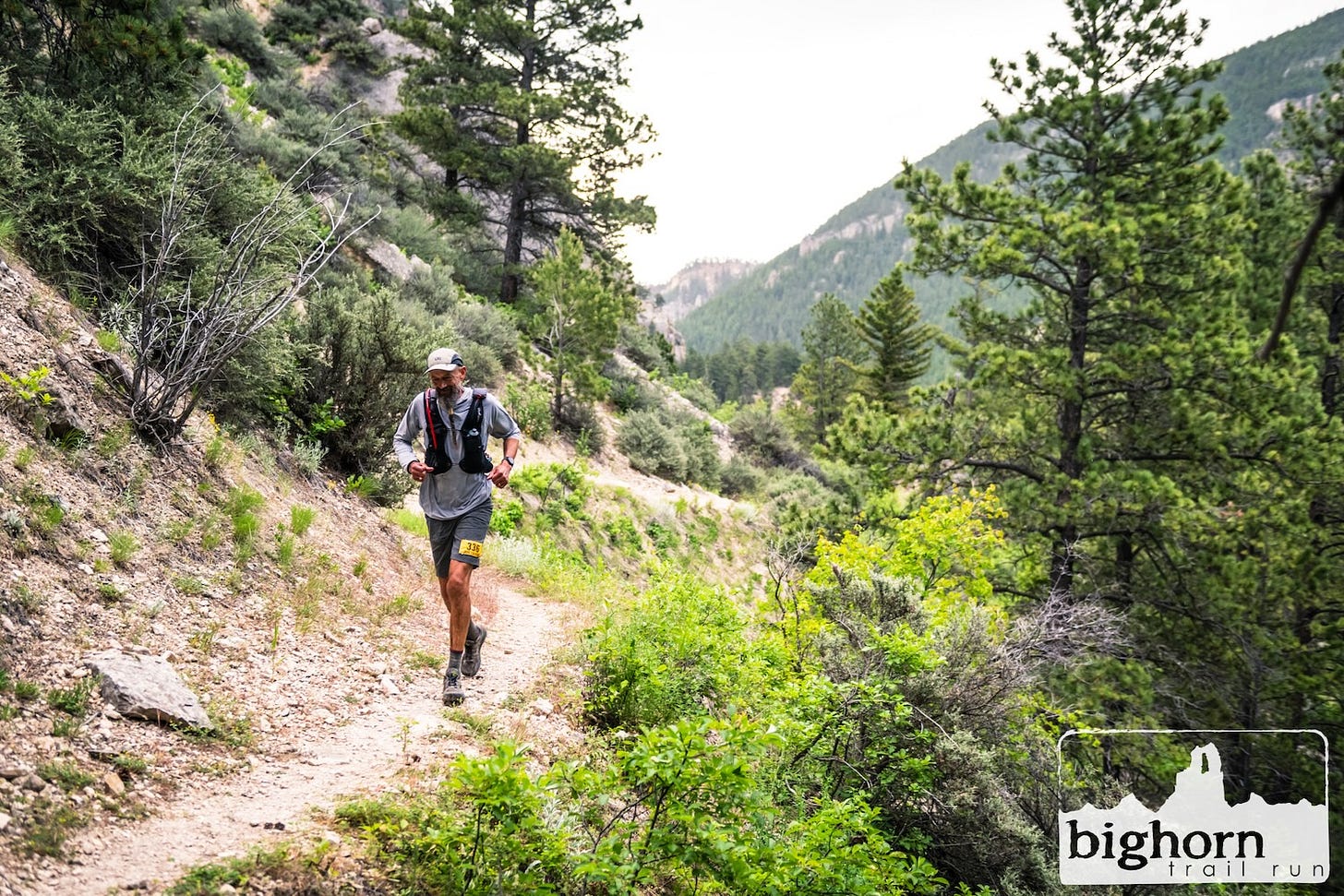In the Stillness After the Race
The cycles of ultra, from intensity to repose (and back)
I ran the Bighorn Trail Run last weekend, a 100-miler in Wyoming’s Bighorn Mountains. The associated travel back to Pennsylvania ended on Tuesday with a long day of driving and flying and driving some more.
On Wednesday morning, I woke into a familiar post-ultra stillness.
The trip was over. My crew, the people I’d just spent so much time with, were back to their day jobs. The emotional highs of the run and the finish line had faded from my mind, just as the minor post-race aches had faded from my body. I was back in this other, “normal” world where no one really cares how far or how fast you ran (or how bountiful the wildflowers were, how steep and rubbled the trails were, or how deep the mud was). Other than my shiny new belt buckle, the only evidence I had that I’d even done the thing was a duffle full of jumbled gear, laundry, and leftover supplies.
It was quiet, and it felt completely, blessedly still.
That stillness is already fading, but here in its final shade, I’m thinking about this cycle of intensity and repose, and how it fits into the larger flow of our lives, nourishing our spirit and preparing us for the next round.
(This isn't just a running thing. Replace “race” with game or match or meet, fight or climb, speech or drill — any endeavor or adventure that has demanded your intensity, the earnest focus and application of your full capacity… if you have put the best of yourself out there in worthy engagement, I think you’ll recognize these stillnesses and the role they can play in our lives.)
There are actually two distinct periods of stillness after an ultra…
The first stillness
The first stillness begins when you've stepped away from the finish line, when the cheers (for you) have faded and the focus has shifted to the next finisher. After all those hours you finally sit (or lie) down, and the most immediate pain of the effort slips away.
This is where Afterglow lives (reason 6 from my Why Run Ultras? post), and the only thing required of you is to sit with it and feel it, allow it to emerge from your overheated core. During these fleeting precious moments, it’s possible that your senses may heighten, and you may see more sharply, hear more clearly. Your emotions (wherever they fall on the spectrum between triumph and regret) are likely to be mellow and accepting of themselves. And above all of it, there’s a deep sense of relief for the fact that, in clear conscience, you can just sit — no more forward motion is demanded for right now.
Savor this first stillness for its shortness and intensity, because it is brief. You can try to hold on to the essence of it, but soon (in minutes, perhaps hours if you’re lucky) it will fade into the pressures of hunger, gear-gathering, the ride home.
The second stillness
At some point after the race, you’ll wake up like I did on Wednesday, into a different stillness. If you're lucky, it will include some soothing silence and stillness, but it’s likely there will also be a vague sense of disorientation and melancholy. Finally released from months of obligation to a disciplined train-up, you might feel a bit adrift.
This is fine, a natural — even critical — part of the process. Just as you strengthen your body through deliberate cycles of overload and recovery, so too you can strengthen the spirit of your greater running self with some intentional indulgence during this second stillness.
That probably means allowing some laziness, and perhaps some minor gluttony. It means your runs can have a different tone, with less intensity, easier routes, more freedom to explore (and if you need to take a short break from running, that’s fine too). It’s a chance to shift some of your training time to other pursuits, or to just sitting quietly on your deck, watching the world go by.
Give this period the time it deserves. But also, be patient and watch, because eventually, the inevitable question at the heart of it all will arise: “What’s next?”
What’s next?
I’ve learned to approach this question in three parts: I analyze the past, I consider the future, and then I return to the grind, hopefully with enthusiasm and a renewed sense of purpose.
Analyzing the past means taking a conscientious look at your recent performance, the training that went into it, and the value of the experience.
For me, this starts with an initial download of raw impressions to freeflow notes about what I saw, how I felt, and what I did. The emphasis is on “raw” — I try to do it as soon as I’m reasonably coherent, and I try to capture everything I remember, anything that made an impression. This is not analysis, it is capture, and the longer I wait to do it, the less value it has.
Analysis comes later, and without urgency. I include objective facts like split times, paces, training miles, ascent totals (all those numbers…), along with my subjective evaluation of things like mental preparation and mindset, decision-making, race strategy and tactics… all the things that can help me do better the next time.
And finally, the most important (and most subjective) analysis of all: did I get at least as much out of this endeavor as I put into it? Was the whole thing worthwhile? Is it worth doing this, or something like this, again?
Considering the future begins with the answer to that question, and so far in my running career, it has always been at least “yes” (or sometimes “yes, and…” with some escalation of either difficulty or expectations).
Once I’ve established that there will be a next time, the rest is a technicality of personal and family choices around schedules, opportunities, bucket lists…. eventually leading to a decision, or at least a decision tree (if I don’t get into Hardrock, I’ll do this instead…).
Either way, the result is a new target, something to focus upon for the ongoing grind.
Returning to that grind is the only non-negotiable part of the whole thing. Regardless of what your game is, if you’re going to keep playing it, you’ll have to return to the grind.
And you’d best find a way to love that grind. Choosing a next thing can help motivate you and focus your efforts, but it’s your consistency and dedication to the grind itself that will get you there. If it isn’t elevating you and making you a better human, then you’re probably playing the wrong game. If it is, it will carry you naturally into the next challenge, and the next.
And that’s it: intensity begets stillness, and from that stillness comes the next intensity, and the cycle ebbs and flows just like that…
Maybe for the rest of your life.





Liked that race. Terrible electrical storm and lots of rain getting to that cool aid station by the water and then knee deep post-holing for miles in slush heading up to the turn-around. Feet and legs were so frozen that after I warmed up at the half way point I found a late ride back to the start with a midnight cowboy and settled for half a hundo. Congrats on your effort and buckle, Jeff. Here is one from my archives, just for giggles, trending right now that I think you will appreciate: https://elcuervoviejo.blogspot.com/2020/03/just-for-giggles.html
I am still recovering from Utah's Snow Peaks 50M two weeks ago in 85-90 degree temps, Ugh! A 55K and 50K in two and three weeks coming up in Wyoming. Enjoying my stillness here, without much running!!!
Oh, I forgot to offer a “what’s Next” option.
What about a “Recover on the Run” at Ironstone 100K. With a 2pm start, it might be right up your alley. Ok, I know what you might be thinking; this is not a recovery race option. Ah ha, it might surprise you.
I challenge you to think it through if you feel your body is recovering well from Bighorn and you need a wildcard challenge for something different to tackle. Just a thought: )